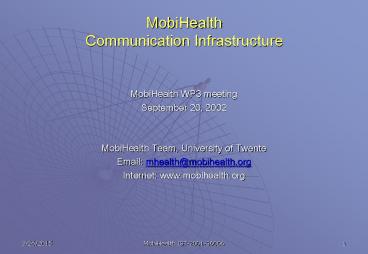MobiHealth Communication Infrastructure - PowerPoint PPT Presentation
1 / 15
Title:
MobiHealth Communication Infrastructure
Description:
Title: Mobile Health Communication Infrastructure Subject: Obtaining requirements Author: Richard Bults Last modified by: bults Created Date: 2/12/2002 9:06:24 AM – PowerPoint PPT presentation
Number of Views:84
Avg rating:3.0/5.0
Title: MobiHealth Communication Infrastructure
1
MobiHealthCommunication Infrastructure
- MobiHealth WP3 meeting
- September 20, 2002
- MobiHealth Team, University of Twente
- Email mhealth_at_mobihealth.org
- Internet www.mobihealth.org
2
Presentation Layout
- MobiHealth Communication Infrastructure
- Communication Requirements
- How to proceed?
- Info MobiHealth testbed Netherlands
3
MobiHealthCommunication Infrastructure
- Communication infrastructure for bi-directional
multimedia data communication between a
MobiHealth BAN and arbitrary host on the
Internet. - Communication infrastructure issues
- Speed
- Coverage
- Availability
- Scalability
- Mobility
- Security
4
MobiHealth ExternalCommunication Environment
IEEE 802.3/11/15
IEEE 802.11/15 2.5G, 3G
IP
? Focus
2.5G, 3G
5
Communication Requirements
Communication requirements are derived from the
MobiHealth system requirements. MobiHealth
system - application, BANOS, BAN
- GPRS or UMTS as bearer service (mandatory)
- IP network protocol (Internet standard)
- Performance (e.g. goodput speed, delaymax)
- Coverage (GPRS and/or UMTS)
- Reliability (e.g. packet loss, availability)
- Traffic management (e.g. prioritization of data)
- Mobility of a BAN (network node)
- Security (e.g. authentication, authorization,
encryption)
6
Communication Requirements (cont.)
- Performance
- Depends on BAN application MobiHealth trials
- example MST trauma team
- Bandwidthu peak(ti30) 236 kbps, sustained
20-100 kbps - Bandwidthd 64-256 kbps
- Max speed E2E connection speed slowest segment
- GPRS 14-112 kbps (CS2 coding)
- UMTS 64-144 kbps
- High delay between transmission and receipt of a
packet - GPRS 1500ms avg. (ICMP) roundtrip delay
- UMTS ???
7
Communication Requirements (cont.)
- Coverage (GPRS and/or UMTS)
- Depends on BAN application MobiHealth trials
- example
- City of Barcelona (ES), Lulea (S) region,
Enschede (NL) city centre, Duisburg (D) region
8
Communication Requirements (cont.)
- Reliability
- Transport of patient vital sign data, remote
control of BANs. - What to aim for? 99.999 uptime? 100 error free
communication? - Where to implement?
- Application Layer
- protocols http,
- Transport Layer
- CO service (TCP) E2E reliable delivery, flow
control - CL service (UDP) unreliable delivery, no flow
control - Lower Layers (Network, Link, Physical)?
- How to evaluate reliability of MobiHealth
infrastructure?
9
Communication Requirements (cont.)
- Traffic management
- Transport of patient vital sign data, remote
control of BANs. - Guaranteed bidirectional communication in
congested networks - MNO, Internet, Enterprise network,
- Mobile Network Operators No voice over data
priority scheme! - How to deal with traffic management in the
MobiHealth infrastructure?
10
Communication Requirements (cont.)
- Security
- Transport of personal (medical) data, remote
control of a BAN, - Is end-to-end (BAN-to-Internet host) security
needed? What level? Depends on user requirements
(WP1)! - Security can be added to most communication
layers! - Different security features depending on layer
- Link layer Bluetooth, GPRS/UMTS, ...
- Network layer IPsec, ...
- Transport layer SSL/TLS, HTTPS, ...
- Application layer Data encryption (OpenSSL
Libraries, MIME)
11
Communication Requirements (cont.)
- Mobility of a BAN
- Cross border connectivity?
- Speed limitation? (e.g. MST trauma trial 80-100
km/hr) - Application disruption?
- How to handle handovers?
12
Communication Requirements (cont.)
- Mobility of a BAN
Horizontal Handover
13
Communication Requirements (cont.)
- Mobility of a BAN
Vertical Handover
14
How to proceed?
- WP1 user requirements needed
- Performance, coverage, reliability, security
- WP2 system requirements needed
- Derived from WP1
- WP3 communication infrastructure requirements
- Derived from WP1 and WP2
- WP3 preliminary testing
- testdrive with plain IP E2E communication
- develop measurement strategy
- performance, reliability (incl. mobility),
coverage, security
15
MobiHealth testbed Netherlands
16
Internet Layering Model
- Application Layer (L5)
- supports network applications
- protocols http, smtp, ftp,
- Transport Layer (L4)
- provides service of transporting L5 messages
between hosts - CO service (TCP) E2E reliable delivery, flow
control - CL service (UDP) unreliable delivery, no flow
control - Network Layer (L3)
- routing of datagrams between hosts (src/dst)
- IP, routing protocols (e.g. RIP, OSPF, BGP)
- Link Layer (L2)
- datagram transfer between adjacent network
elements - Ethernet, PPP
- Physical Layer (L1)
- bit transport on the wire































